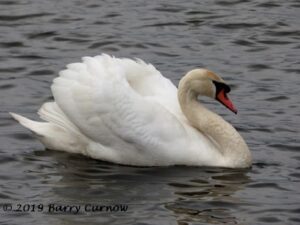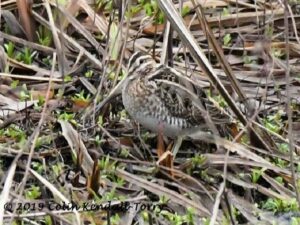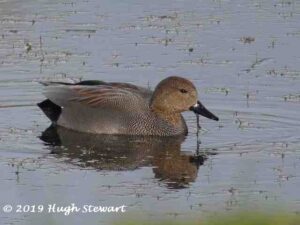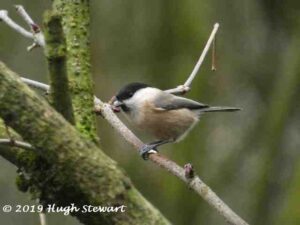Field Meeting Reports – 2019
Denhall Lane and Dee Marshes – Saturday 14th December 2019
Our December pre-Christmas field meeting does not have a brilliant record because of adverse weather. Today didn’t promise much other than cold, rain showers and wind. Dropping down to the coast through Burton the showers were clearly visible driving over the marsh from Wales. However over a dozen of us donned numerous layers and after a short delay to allow a shower to pass set off, the marsh brilliant in the low winter sunshine and a lovely rainbow beckoning us on. Sheep and geese grazed while the air was corvid territory, Carrion Crows and Jackdaws but also including a number of Raven whose voices could easily be mistaken for those of the geese. Closer in to the path a pair of Stonechats were easily identified perching prominently at the top of marsh grasses while a flock of Green Finches flitted low down and provided more of a challenge. The presence of feeders at Net’s café attracted other finches and House Sparrows that played up and down the slated roof. We resisted for the time being the call of the café and carried on, pausing briefly to look at Decca Pools where a small number of Mallard, Wigeon, Teal and Shoveler were sheltering from the wind while a flock of Lapwing flew over head.
Next stop was Denhall Quay where we had a fine view up the estuary but were exposed to the wind but fortunately the rain showers had stopped. Wigeon were disturbed from their pool by dogwalkers while a Kestrel hovered and a pair of Goosanders flew over.
The suggestion of retracing our tracks to the café was seized on eagerly and we were soon enjoying warmth and refreshment. The hard liners amongst us decided to walk as far as Burton Point which was enjoyable in the sunshine but yielded only a few birds. Mistle Thrush, Grey Wagtail, Pheasant, a small flock of Linnet, a Buzzard. A Peregrine carrying something and flying to somewhere with a purpose which we couldn’t figure out. The sun disappeared behind the clouds and a skein of pink-feet hinted that it was time to go home.
An enjoyable day once the showers stopped. Thank you all for coming.
Good wishes for 2020!
Mike Hart
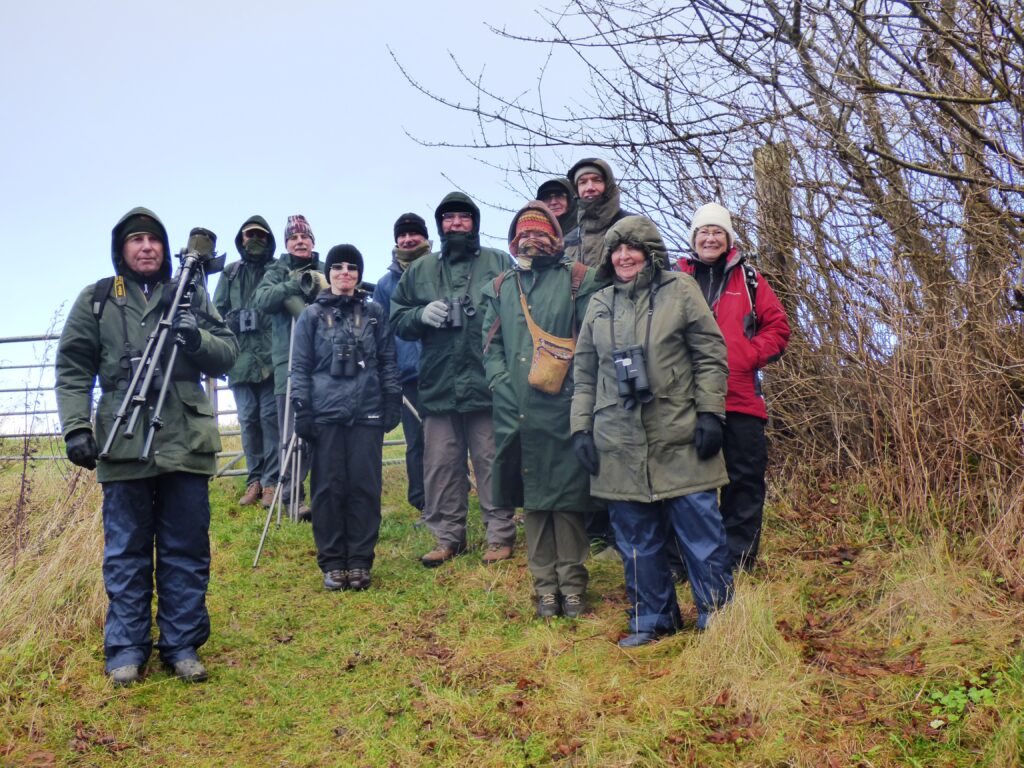
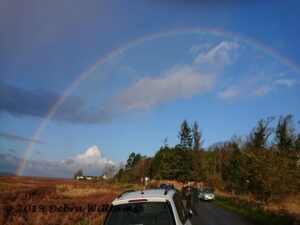
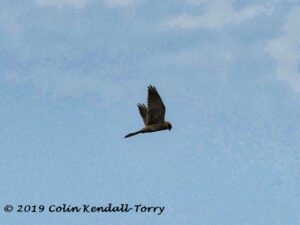
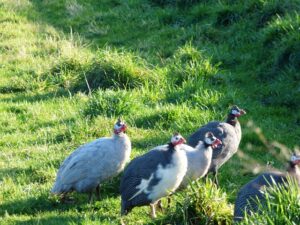
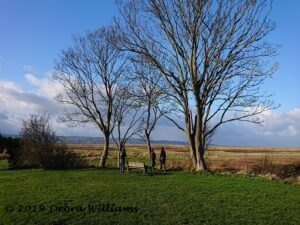
Moore Nature Reserve – Sunday 17th November 2019
An overcast but mild and fine morning saw 17 members meeting at this reserve between Runcorn and Warrington. Some of the best sightings were in the first few minutes as a Kestrel sat on a power line and a handsome Buzzard in the top of a small nearby tree. Redwings and Fieldfares were in the bushes close to the car park. A fine male Bullfinch made a brief appearance, then we were down the steps to the first lake, Birchwood Pool with its three hides giving good views of the commoner waterfowl such as Coot, Mallard and Tufted Duck together with Gadwall, Wigeon and Great Crested and Little Grebe. Unfortunately it started raining and this was to continue in patches throughout the rest of the day.
We walked east through Birch Wood devoid of activity at this time of the year, calling at the hide at Pump House Pool and continuing on to the easternmost Phoenix Hide. En route our attention was drawn to a large gathering of dark birds on the nearby railway bridge. It was easy to jump to the conclusion that they were Starlings, however on closer examination and using our ears rather than our eyes it turned out to be a flock of about a hundred Jackdaws. The excellent Phoenix Hide (though too small for our numbers) is built on a mound overlooking a lagoon on one side and the Eastern Reedbed on the other. No Bitterns were on show but there was a brief sighting, caught by a couple of members, of the resident Kingfisher. Here it was easy to look down onto the Great Crested Grebes and Little Grebes and wonder at the contrast between their vivid summer plumage and the ghostly winter garb. The Kingfisher was showing reluctance to make another appearance and so we wandered back the way we came in the increasingly heavy rain to the car park where we continued with lunch “on the hoof”.
While some members decided enough was enough, a dwindling number spent time at the Lapwing Lake hide and were rewarded with a sighting of another Kingfisher. The dull weather and dwindling light did not prevent the Wigeon on Lapwing Lake showing well in their colourful plumage. At the feeding station nearby there was a continuous stream of small birds, mostly the commoner Tits but also a lovely Willow Tit amongst them and a Robin and Nuthatch nipping in now and then. A female Great Spotted Woodpecker had another feeder to itself and was gorging away. A walk along the sunken route of the old canal and then it was back over the other side of the lake, taking in the Cormorants going to their roost up in the birch trees. Reluctant to leave even in the rain we took a lingering look at the ship canal with its swing bridge. What a feat of civil engineering, now largely neglected and sadly derelict! Time to go home.
Mike Hart
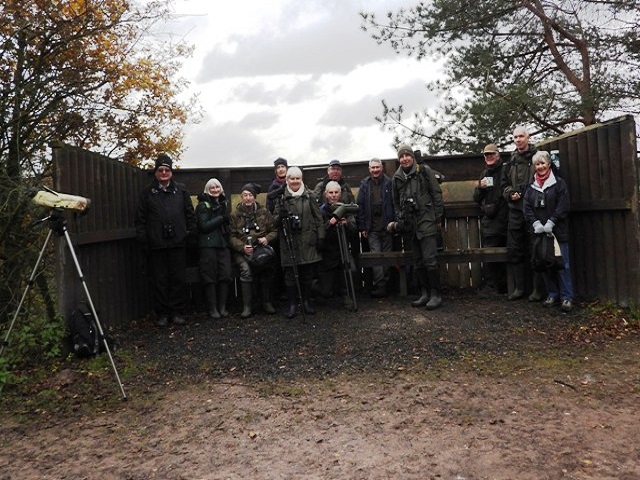
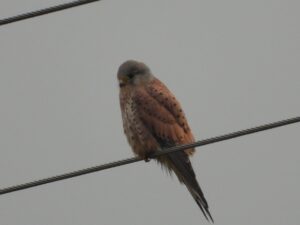
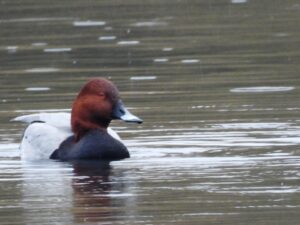
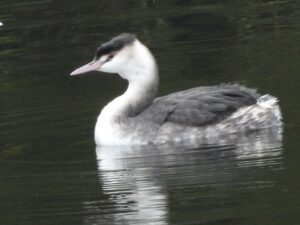
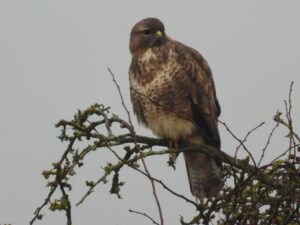
Point of Ayr – Saturday 2nd November 2019
The weather forecast was not encouraging with a large slice of luck needed. The TV charts had shown a huge low revolving over the Irish Sea and rain was falling heavily on the drive out to Talacre. However eight of us assembled in the car park and started out along the path and boardwalk Northwards. Looking down into the flooded scrub we noticed a pair of Stonechats flitting from bush to bush and showing well for us. A pair of Robins competed for posing rights.
We walked through the gap in the sand dunes emerging onto the beach with the familiar leaning lighthouse in front of us. The rain was easing and visibility improving as we scanned the sand for birds but there were only a few of the regulars, Herring Gulls, Cormorants and Oystercatchers while Pied Wagtails flitted around our path. Heading around the corner towards the estuary we paused to look over the lagoon which has been formed by the advancing sand spit. At least eight Little Egrets were in evidence although the muddy gullies could provide cover for dozens more. A number of small “LBJs” gave us much discussion as to their identity and there again the mud and grasses provided excellent background to disappear into. Linnets was the final decision.
After turning back at the RSPB rope barrier, erected to protect birds roosting at the end of the spit from human encroachment, we made our way back to the cars for lunch. The rain had now stopped although heavy cloud held the threat of more to come. Refreshed, we strolled along the sea wall of the lagoon looking in vain for the resident Kingfisher. A flock of Lapwings headed inland as small birds including Wrens, Robins and a variety of Tits teased us with their briefest of glimpses in the hedge.
Arriving at the RSPB hide, the sunshine was lighting up the end of the spit where several thousands of waders roosted while numerous ducks paddled about on the watery inlets. A solid black line indicated the Oystercatcher camp while on the edge of the tide grey waders would include Curlew, Knot, Grey Plover and Dunlin. Ducks included Shelduck, Pintail, Teal and Wigeon. After we had sat watching the comings and goings of these birds for some time there was a sudden disturbance and Oystercatchers started to stream away across the water. Everything followed until the spit was devoid of birds and then half a dozen humans with their dogs appeared, having defied the warning notices. Stupid people and very annoying!
Apart from that, fortune favoured us with the weather and all in all a good day out.
Mike Hart
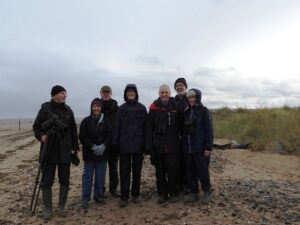
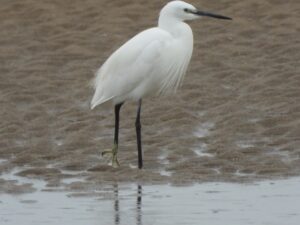
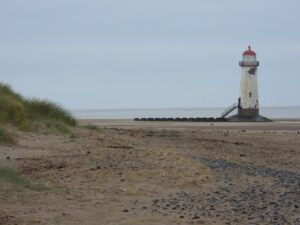
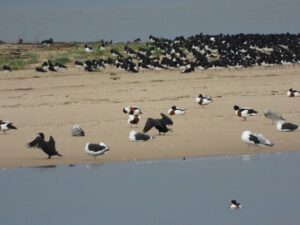
Wirral North Coast – Saturday 28th September 2019
The weather forecast wasn’t encouraging and I wasn’t surprised that no one else was parked up when I arrived. However Joyce had followed my tortuous route to the front so I wouldn’t be alone. Just opening the car door against the wind was an effort as was the scramble to grab the loose items which threatened to escape and litter themselves over the beach to New Brighton.
Astonishingly there were soon sixteen of us assembled in the lee of the toilet block (at one time we were up to eighteen). Despite the rain which had by now started everyone was full of enthusiasm and eager to get off. The tide was advancing rapidly and, as usual, driving before it a flock of Oystercatchers. Those flying at ground level looked to be making better progress than those higher up which were almost flying backwards! Perhaps those actually on the sand marching against the wind were best off.
We made our way from one shelter to another, finally arriving at the lifeboat station. The Oystercatchers were still the most numerous species by far although tagging along with them as they moved ahead of the advancing tide were small numbers of Redshank, Knot, Curlew and Dunlin. Four Sandwich Terns and one or two Bar-tailed Godwit were picked out. A number of Shelduck and the usual number and variety of gulls were also present.
The skies were lightening, the clouds breaking up and the sun showing itself as we were tempted to walk just a little further (always with some shelter as the next goal, note). One or two Pied Wagtails were seen on what bit of shore remained uncovered by the tide. Several Meadow Pipits had been seen flying over in the rain earlier.
Although the sun was now shining we decided that we had done a fair morning’s effort against the rain and wind and there was little to gain by staying longer. Some returned, with the wind behind them, back to the cars while half of us repaired to Popsy’s café over the road at Hoylake Community Centre for refreshments and a chat. This is always a welcome aspect of any field trip and today was no exception. I recommend Popsy’s.
In conclusion, while bird numbers and activity were not exceptional the enthusiasm and camaraderie that was evident in the face of adverse conditions was great to experience. Well done and “Thank you” to everyone.
Mike Hart
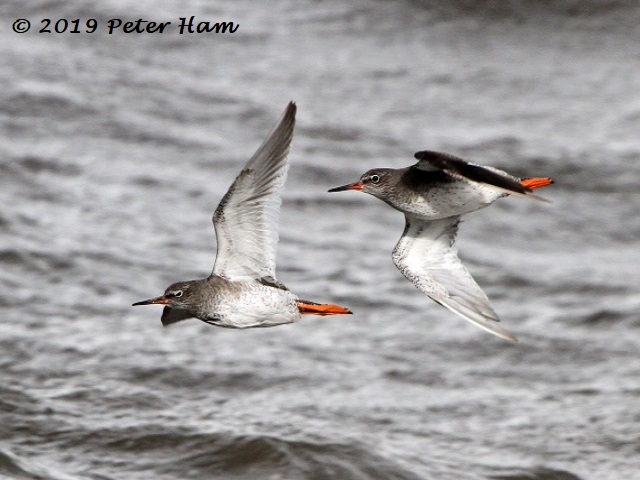
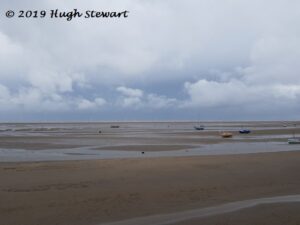
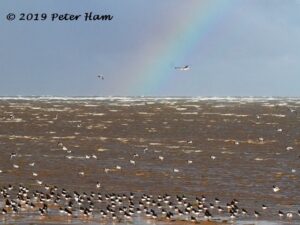
Red Rocks and Hoylake – Friday 30th August 2019
This was to have been an outing to Hilbre Island with a stay over the high tide period, however the island had been temporarily closed to the public after a fire.
As it was, sixteen members turned out on a cool, overcast and blowy morning. The walk out from West Kirby up to Red Rocks was rather quiet although we did have a Peregrine Falcon cruise overhead and a solitary Swallow flash across the Royal Liverpool Golf Club. Far over the estuary Cormorants and Oystercatchers lined the sandstone reef between the islands while several Little Egrets skulked in the saltmarsh closer in.
Rounding the corner of Wirral we were presented with the muddier expanse of Hoylake shore. The tide was still some way out and we carefully picked our way towards King’s Gap finding some respite from the breeze in the small bay. Soon we noticed a small flock of waders, Dunlin, Ringed Plover and a few Sanderling. A steady stream of birds came from around the corner in the Dee Estuary as the tide flooded there and they sort refuge on the Hoylake shore.
We found ourselves on an expanse of spartina grass, yellowed by the recent controversial application of a weedkiller to prevent Hoylake following the fate of Parkgate. The birds didn’t seem to mind and soon the small flock had grown to many hundreds, supplemented by several Knot, one or two Bar-tailed Godwit, Grey Plover and Turnstone. A number of these birds were still showing breeding plumage which is such a contrast to the winter drab shades of grey. Several Sandwich Terns were lingering by the water. Oystercatchers were along the tide-line in their thousands like a miniature army marching together to who knows where?
Out at sea our sharper-eyed members spotted a Pomarine Skua and later on a couple of Arctic Skuas were over Hilbre and three Common Scoters.
The tide turned and we chose to return to Red Rocks overland rather than by way of the shore, avoiding the wind in our faces and adding a migrating Wheatear to our list en route.
It wasn’t Hilbre but we had a very enjoyable and productive outing, probably seeing more birds and certainly having wonderful views of them.
Mike Hart
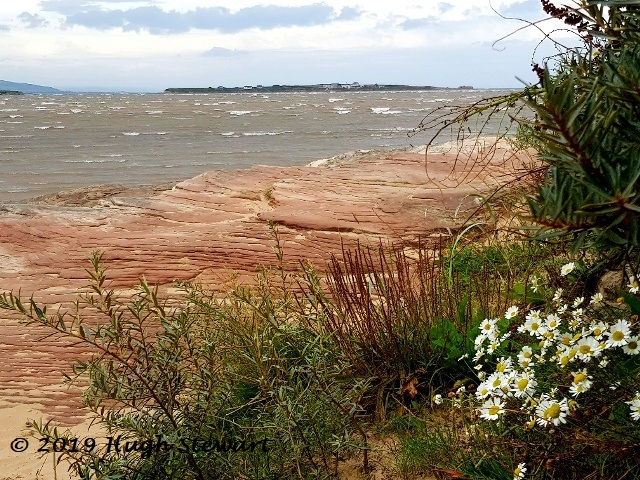
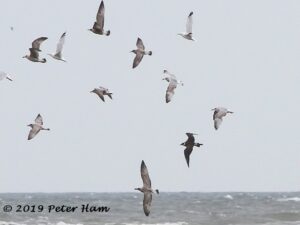
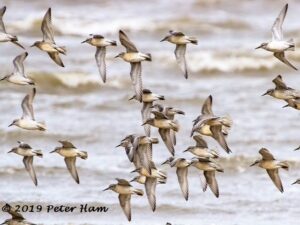
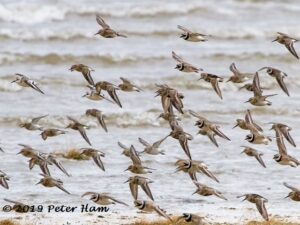
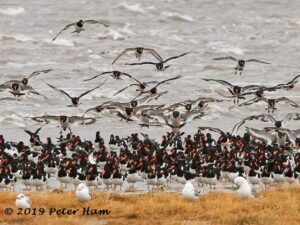
Gronant – Wednesday 17th July 2019
A dozen of us met at the car park on Shore road. Sunshine but breezy, what to wear? Along the road we went, thousands of caravans on the site to our right, country to our left. Over the railway bridge and onto the coastal path and we were immediately tip-toeing avoiding the many Cinnabar Moth caterpillars that felt it necessary to cross the path. Quite a long pause on the little bridge that crosses the Prestatyn Gutter, a Little Egret skulking round the water station, Mallards and Moorhen with young, a Grey Heron motionless in the reeds, a Sedge Warbler, Wren and several doubtful identities (not the last of the day!) mostly of young birds including a ‘chat’ which flitted low around the reeds but was caught on camera (possible ID?) by one of our number.
And so onto the board walk that leads to the viewing platform and onto the beach where the tide was coming in. A short way along the sand we stopped and focussed on the waders and terns being driven up the sand spit by the rising water. Good numbers of Dunlin were in breeding plumage as were the few Sanderling. Of course the main attraction were the Little Terns, both adult and youngsters that were settled on the sand but frequently took to the air and did a little fishing. How easily they become invisible against the sky but they are quite noisy little birds and easily located by ear. Two Peregrine Falcons were seen over the sea but they kept their distance from the colony. Stretching ahead of us up the shoreline were the fences of the nesting site. Rope to deter humans, electric (powered by solar panels) for foxes, stoats and hedgehogs. Kestrels are deterred by vigilant wardens and volunteers. The area which requires fencing grows each year and steadily moves Eastward as the shingle spit extends through weather and wave action. It will take an army of wardens and volunteers a week to get it dismantled in mid-August.
The sun was shining, the sea and sky were blue, sand golden, a fresh breeze – paradise! But we had to move and the group broke up. Some stayed and had lunch and later explored the down the length of the dune to the wardens’ hut and the tiny hide. The hide has the best view of the nesting area but unfortunately is very small and would be a problem to a group of any size. We were able to get closer views of the terns and also Ringed Plover. On the walk back we were amazed at the number of birds that frequent the dune slack, with flocks of Linnet, Meadow Pipit and Goldfinch and a number of Skylark. Although past their best Pyramidal Orchids were numerous and Sea Holly abounded. The rain began as we reached our cars. Nice timing!
Mike Hart
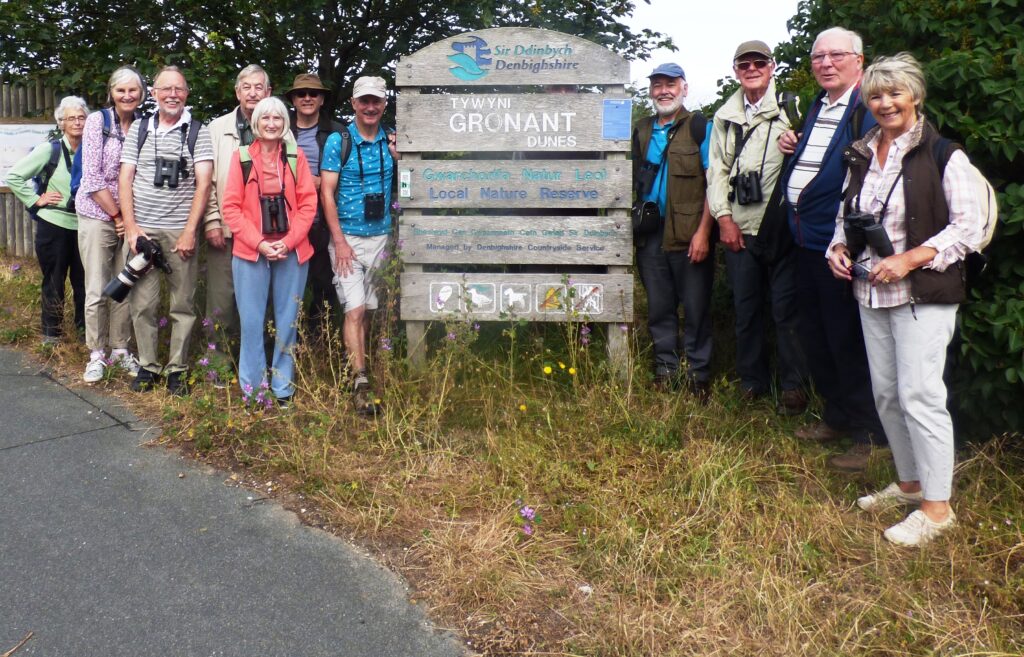
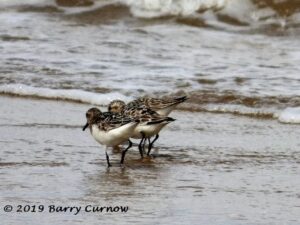
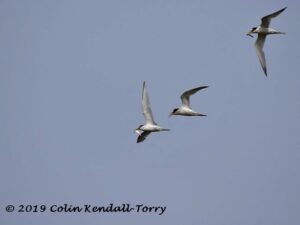
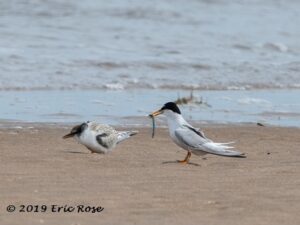
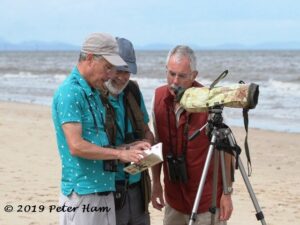
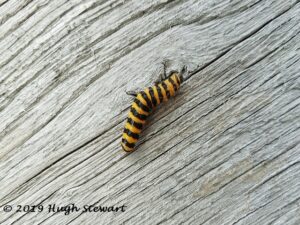
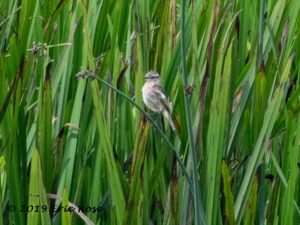
RSPB Leighton Moss (by coach) – Saturday 15th June 2019
I expect that most of us were watching the weather prospects for our day out with dismay during the preceding week. It was a coach trip so we were all committed to going and as it turned out it was not at all bad. The sun was shining (mostly), the air was warm and we only had a little rain and that on the journey home.
Arriving at the reserve we were greeted by David, a long-standing staff member who briefed us on what was going on and what we might look out for in our time there. Then it was off to explore the various hides (or café or shop I suspect of some!) the majority of members choosing to start with the longer walk along to the Causeway Hide where Reed Buntings were flitting around right under our noses while Little Grebes bobbed about close by and Great Crested Grebe were more distant.
A Lesser Black-Backed Gull shared a nearby islet with a Cormorant. A mother duck with five ducklings provided a lot of speculation as to its identity and without Hugh’s presence to help us there was an awful lot of debate and field-guide consultation before Pochard was settled on, the final decision being made with the presence of a male later.
Along to the furthermost hide, Lower Hide, where the close-in attraction was a Lapwing with a single chick on its nest of a pile of straw. Further off we had the treat of a Bittern standing in the reeds in classic pose with its neck stretched straight up towards the sky. I must admit that we had the help of a RSPB volunteer who pointed it out to us, so “Thank you” to him. Walking back, we were pleasantly surprised to find a family of Greylag Geese quietly minding their own business in a small trackside creek. Easily missed.
Back to the visitor centre (with a stop to check on the Pochard I.D.) and the next attraction was the “Sky Tower”, a thirty foot high steel tower which gives a panoramic view across the reserve. (note to self – book Alton Towers next year). I arrived at the top to find half of Wirral Bird Club there, Steve and Karen bubbling over with excitement at having been looking down on a couple of passing Marsh Harriers which were very close in. Perhaps not as exciting but we could also look down on the various birds on the water including pairs of Gadwall and Garganey, a number of Mute Swans with cygnets and several Black Headed Gulls on nests.
On to the Tim Jackson hide where we watched a feisty Coot taking on an intrusive Carrion Crow and then, to finish off, at the Grisedale hide we were treated to Marsh Harriers obviously nesting as they made repeated journeys back and forth to an unseen location on the fringes of the reserve. And so back onto the coach and a good run home.
Mike Hart
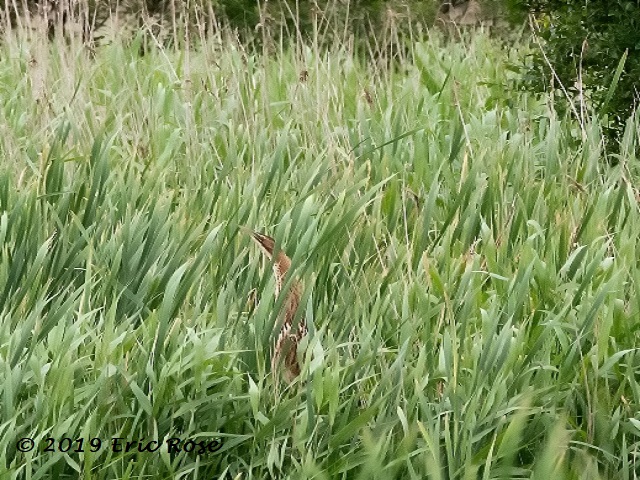
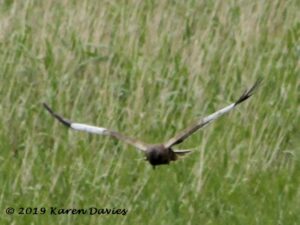
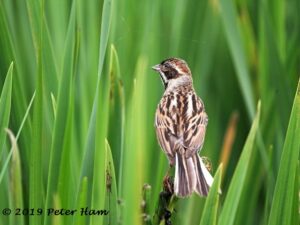
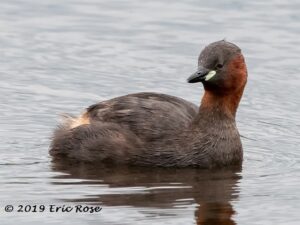
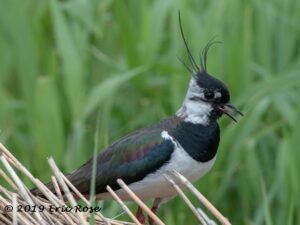
Beeston – Saturday 25th May 2019
I was desperately hoping that the number of members turning out might improve on the last field meeting. I really wasn’t expecting eighteen in total but then it was a lovely morning with the sun shining and the birds singing (always a good sign!).
And so we started off from the Castle Car Park through the pine wood and out onto lovely farmland under Peckforton Hills. Buzzards, Carrion Crows, Rooks and Ravens were flying high while Jackdaws pecked in the fields where Pheasants hid in the grass. Bushes and hedgerows concealed many small birds which could be heard but not seen. A small herd of heffers commanded our undivided attention as we moved through their field. Sensibly neither they nor us got overexcited. Next it was on to the electric fence obstacle. I crawled under it on hands and knees, Hugh approached it with a dead tree branch, Derek was advocating touching it with a green leaf, while Pam just lifted it up with her hand and the rest of the party walked underneath. Our heroine!
Pausing for a sit down refreshment break we had our first sighting of Peregrines. Very high and distant but well spotted, Tim. More concealing hedgerows and trees and distant sightings of raptors as the approach of lunch and The Shady Oak lured us onward. Arrival at human habitation and the canal produced a sudden flurry of bird activity with Swallows and Housemartins busy nest tending and even a Treecreeper making a fleeting appearance. Moorhen and Mallard with ducklings were at home in garden ponds while a majestic Mute Swan cruised the canal no doubt anticipating scraps from pub patrons.
Refreshed, we strolled the towing path past Wharton’s lock (known to those who have been on club canal cruises) and it was here that those birds that had previously been skulking out of sight made themselves visible. We started off with a Song Thrush collecting invertebrates for a young family hidden in the undergrowth. Next we had a very good view of a Chiffchaff singing at the top of the hedge and then a handsome male Blackcap which rewarded our patience by showing himself off well. Finally the continuous chunnering in the hedge materialised into a Sedge Warbler which we were very pleased to put a name to. The sharp alarm of a Great Spotted Woodpecker came from the trees on the far bank.
On the slow walk back uphill to the car park (more cows and a totally uninterested bull) we were able to make out the silhouette of a Peregrine which Hugh had spotted earlier high on the crags close (presumably) to its nest.
Not too many birds to be seen at this time of year, but a good off-road walk in lovely countryside, warm sunshine and … we missed the rain!
Thank you for coming.
Mike Hart
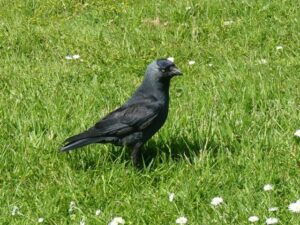
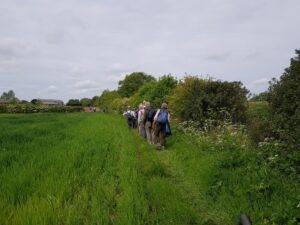
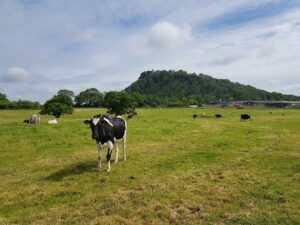
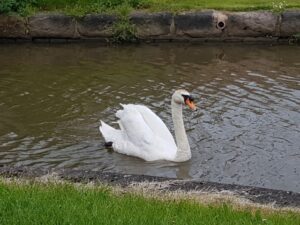
Maeshafn – Wednesday 1st May 2019
Unlike the previous two days the weather was not forecast to be good. At least the rain was “light” rain, there was no wind and the temperature was reasonable. I had previously visited the location two weeks earlier and Spring had really transformed the scene in that time, the trees now clothed with fresh green leaves and what had been barren-looking fields, now showing new crops sprouting vigorously. The Rookery on the far side of the main road was virtually invisible in the treetops.
We started easily, downhill, to where the River Alyn flows towards Loggerheads. Small birds, finches and Blackbirds, flitted in and out of the hedgerows. It was now time to regain lost height and up we climbed steadily, the rain stopping in the meantime, common small birds in attendance, eventually reaching the woodline. Strangely, once in the woods it became very quiet and it wasn’t until we reached the outlying human habitations in Maeshafn that birdsong picked up again. We took the opportunity to take a sit and snack on the only bench and watched the Blackbirds and House Sparrows busy with their nests in the nooks and crannies of houses or buried deep in their ivy cover. A solitary Siskin mixed with the Chaffinches and Goldfinches on the telephone posts.
‘Mostly’ downhill I promised from then on. ‘Mostly’ A gentle descent through Aberduna Local Nature Reserve gave us views of The Clwydian Range and lots of bird song and call to identify. A Common Buzzard soared over the valley. Goldfinch were in and out of the hedges, a Chiffchaff sang high on a tree and a male Black Cap was seen in the hedge. Swallows and House Martins passed by overhead.
Near the valley bottom we diverted down to the River Alyn again, this time passing over a rocky bed through a small wood with the ground covered with Wild Garlic in flower. Chatting to the occupants of a most desirable cottage on the banks of the river at this point, they confirmed that Kingfisher were present and lots of Dippers although we saw neither on this occasion. A short walk and we were back to our cars.
In the afternoon Moel Findeg beckoned with great all-round views and the most obliging Chiffchaffs, Willow Warblers and Nuthatches. A matter of standing quietly and letting the birds come to you!
Nothing spectacular but a pleasant day. Thanks for your company, Bill!
Mike Hart

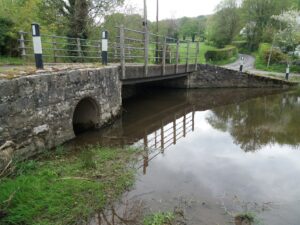
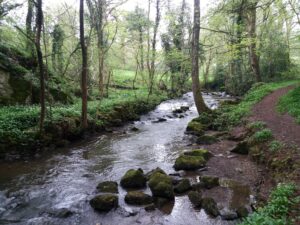

RSPB Blacktoft Sands – Sunday 14th April 2019
“Wrap up well” was the advice coming from the East coast. Wise words to be heeded and take heed we did. Once on the coach we had a speedy and comfortable journey over the Pennines before arriving at our destination on the banks of the River Ouse. This RSPB reserve consists primarily of tidal lagoons and reed beds. The country is flat and low-lying.
The cold wind was blowing in from The North Sea but the sun was shining as we checked out the facilities at the reception hide (hot drinks and a warming stove for later!) We were soon setting out to the other hides, six in number, some double-deckers, all roomy, each one giving a surprisingly different picture of the various species even though they were not far apart.
The most obvious birds of the visit were, arguably, the Marsh Harriers. It was almost impossible to see just one at a time, there were always others in the field of vision, usually quartering low over the reeds. Several were seen to take their prey and ‘food passes’ were seen on more than one occasion.
From the Townend hide we had a great view of the other obvious birds, the Avocets. Theirs was a small flat island in the middle of the lagoon and no doubt nests will become apparent before long. What fantastic looking birds these are, especially when flying.
All the while there was a ‘supporting cast’ of a steady passage of Hirundines in the air while on the water were good numbers of ducks, geese and other water fowl. Shovelers appeared to have paired up and were paddling round each other in tight circles, huge bills sifting the water for food. Teal, Wigeon, Goldeneye, Gadwall were all present and brilliantly illuminated by bright sunshine showing their beautiful colours to best advantage. The discovery of a single Ruff, identified after much discussion, led to several more being picked out while some fleeting glimpses of a pair of Snipe ended up with the two birds slowly parading very obligingly through the grasses right in front of our hide. Absolutely stunning birds! A Yellow Wagtail put in an appearance as we reached the farthest point in our exploration.
There were, of course, lots of other birds, too numerous to list but including a Cetti’s Warbler mostly heard but not seen in the grasses and reeds inland of the hides but then it was time for a drink in reception before boarding the coach for home.
An excellent site, the visit helped by the weather which, while cold, didn’t distract from the birding. Other club members for company and help in spotting and identifying the various species. And a coach to take us home. What better?
Mike Hart
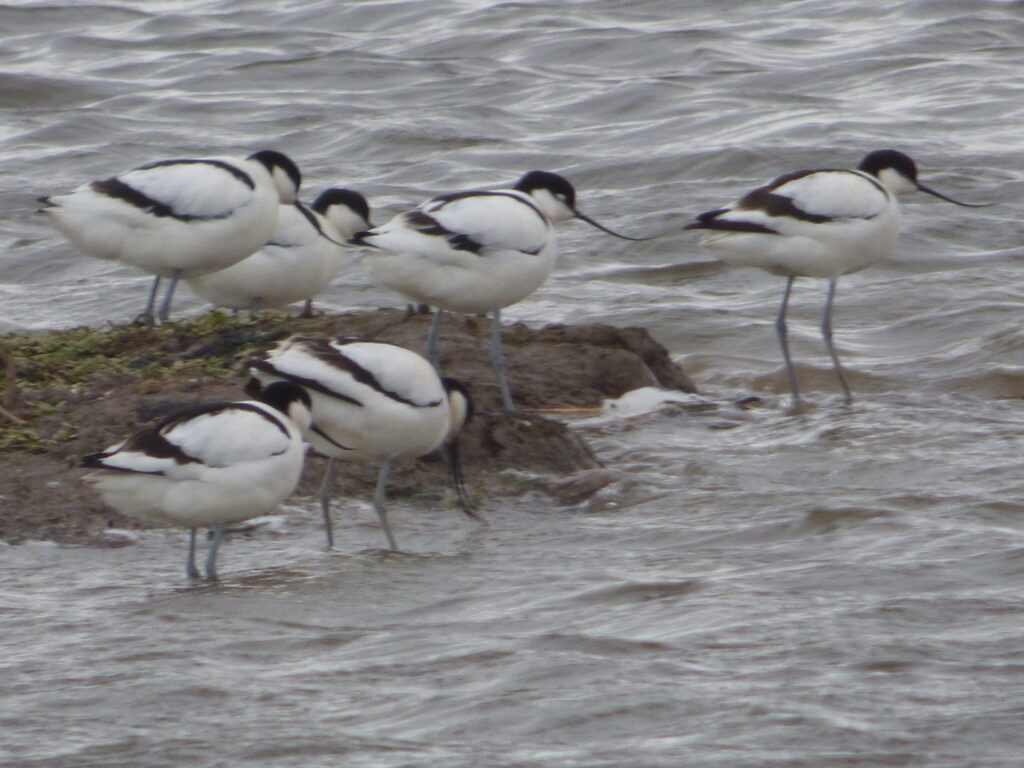
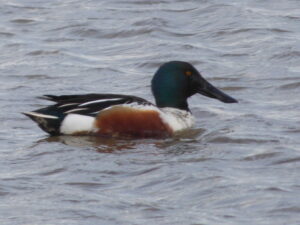
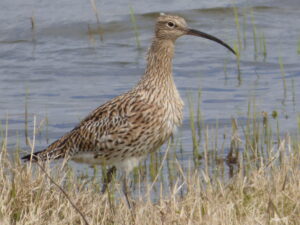
Leasowe – Sunday 31st March 2019
The earlier start of 9am, coupled with the start of British Summer Time stealing another hour in bed meant that it was a great turn-out by the hardy two dozen members who assembled on a chilly, grey morning.
We set off with a short diversionary walk up the road towards the bridge, the fields on either side giving the usual good start to our spotting being busy with Pied Wagtail, Blackbirds, Song Thrush and Curlew. A pair of Fieldfare were showing well and provided a year tick for several members. A cock Pheasant was strutting his stuff beyond the hedgerow. Turning back to our primary route we watched a pair of Kestrels flying around the top of the lighthouse and wondered if they might be contemplating setting up home high in the sky. We were treated to a fine view of a Chiffchaff sitting high in a bush, the morning sun just making its presence seen and felt.
Further on, in the paddocks where a number of horses were grazing, sharp eyes picked out what at first glance appeared to be a white stone or scrap of litter. Unfortunately, there was a fence between us with a lower rail at exactly the wrong height for the average birder to get a clear view. Kneeling down solved the problem although a prayer was said by myself, if no others, that I could get back up on my feet again! It was well worth it to see not one, but two magnificent male Wheatears.
While attention was centred on the Wheatears, there was plenty of activity elsewhere with several Buzzards taking advantage of the warming air to soar off to great heights and on the other side of the sea wall a flock of Shelduck moved location as the tide ebbed. Curlew, quite well camouflaged, could be picked out in the rough pasture among the sheep while the hedgerows accommodated a variety of finches. Walking out towards the sea, we passed two corrugated iron barns which were hosting any number of House Sparrows. Good that not all their nest sites have disappeared under redevelopment.
Out on the sand and mud were small numbers of Redshank, Oystercatchers and Turnstone. A solitary Peregrine was spotted a long way out on the banks. Back on shore clumps of gorse provide cover for any number of overactive Linnets.
After lunch, the day now warm and sunny and our numbers reduced (Mother’s Day?) we walked inland, pausing for some time at the bridge over the Birket, hoping to see the local Kingfisher but having to settle for watching a pair of Long-tailed Tits working on the early stages of a nest in the bankside scrub. The track leads eventually to the railway line but is bordered with high thorny hedges, the Blackthorn blossom being at its beautiful best right now. The star bird amongst the many there was a singing male Blackcap. Last sighting of the day was a suspected Sand Martin, the only Hirundine on show for us today.
Mike Hart
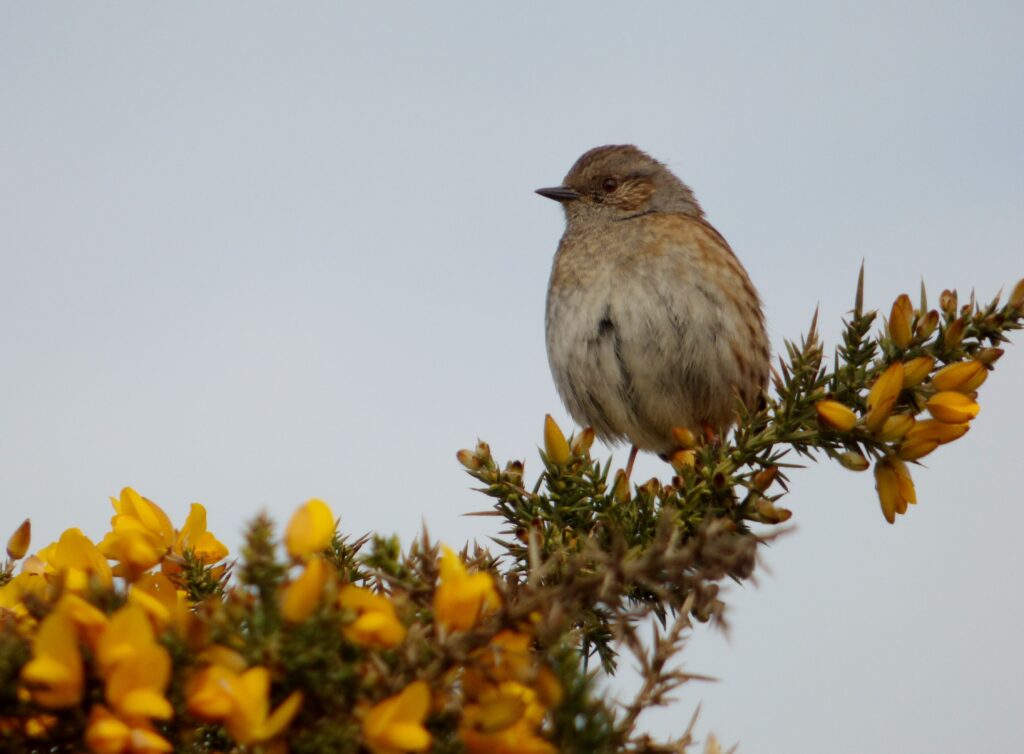
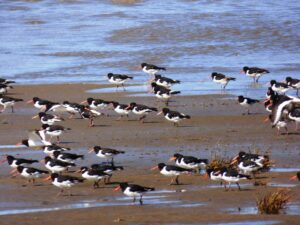
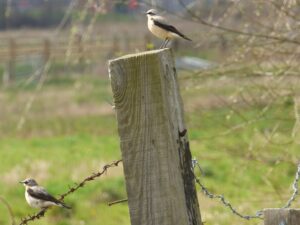
Dyserth – Saturday 23rd February 2019
The Spring-like weather that we had enjoyed in recent days continued so it was with some enthusiasm we managed to squeeze our cars into the ever-shrinking parking area. A short chat with the workmen with their JCB reassured us that we were safe to leave them for the day!
And so we set off and the first sighting of the day, even as some were still changing shoes for boots, was a Dipper working its territory under the brick arch of a nearby bridge. Also seen was its neighbour, a Grey Wagtail, flitting about in the riverside undergrowth. A great start! We made our way slowly, now on the track-bed of the abandoned Prestatyn – Dyserth railway line last in operation in 1973. Robins were, perhaps, the most common bird of the day, easily heard but typically difficult to spot in the still leafless trees and bushes. Treecreepers are always challenging as they move around the trunks and branches and the usual Nuthatch was also seen in the same vicinity.
Two or three Buzzards took to the warming air and we had a great view of one which chose to land in a low branch almost over our heads. The Buzzards continued to soar over us but unfortunately we didn’t get any local Ravens to compare their sizes which exceed the Buzzards. Indeed the only Raven seen was one, identified by its voice initially, cruising over the meadow. Carrion Crows and Jackdaws were our main corvid sightings. A more exciting spot was a Red Kite but this was a bonus for Colin and Pat who had quietly sat down on a bench to have a cuppa! The rest of us carried on until we arrived at Melidan Golf Club where we were able to sit outside and consume our lunches while enjoying liquid refreshments from the club. Tea and coffee, that is! A very welcome break.
Starting the return leg, for a change, we took a parallel footpath and were rewarded with a very difficult sighting of a male Bullfinch almost hidden in the scrub. The Treecreepers were still in their home territory and both the Dipper and Grey Wagtail in the river.
With what was left of the afternoon and with weary legs, a few of us opted to conquer the dizzy heights of Graig Fawr (153m – 500’) which we had been able to see from our lowly railway track. Well, we did cheat and drove up to the National Trust car park before five of us went for the summit, ticking some Dunnocks on the way (We are a bird club, after all!) A neat finish to a good day.
Mike Hart
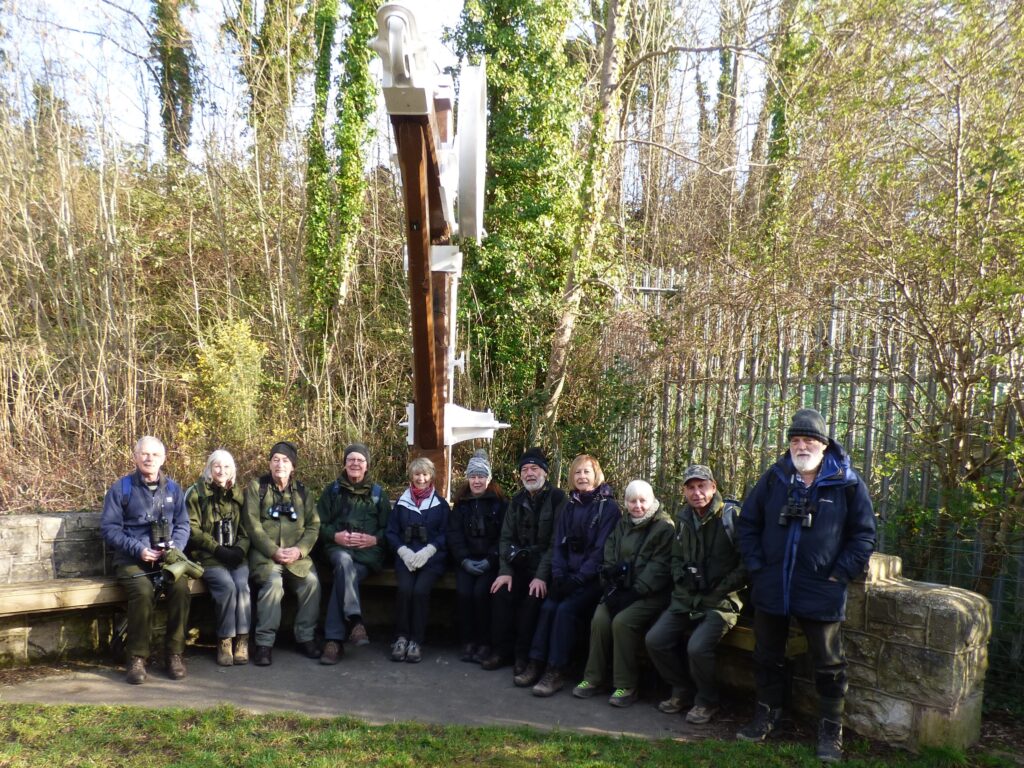


Pennington Flash – Saturday 26th January 2019
It was with some dismay that we found the large car park at this country park nearly full on our arrival but it turned out that these were people intent on keeping fit and participating in the Saturday morning “park run” and they were off home within the hour. Fifteen of us started our day with a look on the main lake at the usual Mallard, Coot, Moorhen and Black-headed Gulls which expect humans to feed them. Farther out on the water and a taste of things to come were Tufted Duck, Shoveler, Goldeneye, Great Crested Grebe and Goosander.
Soon we started out on the circular walk that takes in the seven hides, each one good with its own particular merits. The day was fine, the light was good, and we had many excellent views of the waterfowl often seen as distant blobs but now revealed in absolutely beautiful detail. Early on there was a very brief glimpse of a Kingfisher. Further on and we were wondering just how many Grey Herons the site supported? In the meantime, after much searching, Ken spotted a Common Snipe on the edge of a scrape. Motionless among the dead scraps of last year’s reeds it was relying totally on its ‘cryptic’ colour pattern to keep it safe and how effective was that! A great find.
It was very noticeable that the vegetation and hedging at the side of our paths had been cut back with a tractor-mounted machine. The ragged, torn branches were in stark contrast to the older hedging which had obviously been properly laid some years ago. Perhaps it is a sign of the financial struggle to maintain our open spaces?
After walking as far as the canal, the Leigh branch of the Leeds and Liverpool, we started on the return leg of our walk. Calling at the Teal hide provided arguably the most spectacular sight of the day with a magnificent Mute Swan dominant on the small island, centre-stage, about thirty male and female Goosander drifting in and out of sight and with many Gadwall showing beautifully, and other lesser ducks.
And so to the feeding hide where a multitude of feeders attracted a multitude of small birds. There was constant movement as birds flew in, snatched a small offering and sped off to cover again. Reed Bunting, Bullfinch, and the commoner Tit species were plentiful while the Willow Tit, a speciality of the site, less so but still caught on camera by members. Meanwhile in the adjacent “Pengy’s Hide” (for children?) a Water Rail was showing well in the vegetation right under the windows. While undoubtedly a star attraction it could not detract from several Pochard further out on the lake which were well lit by the afternoon sunshine.
Shortly after our completing the circuit of hides, clouds covered the sky and the promised rain arrived. While providing a challenge for the drivers, we had at least got a great day’s birding in.
Mike Hart
